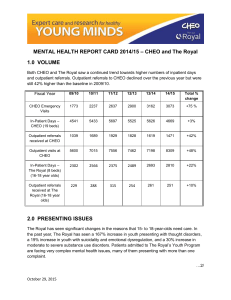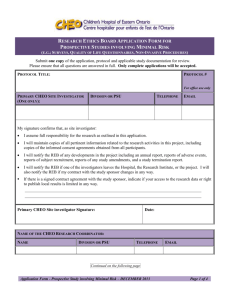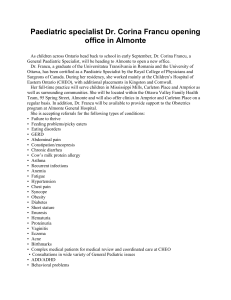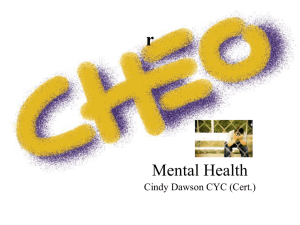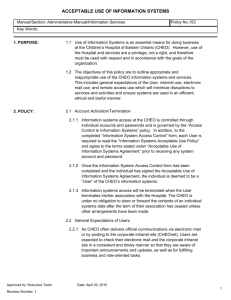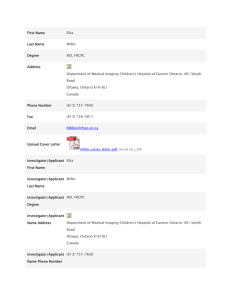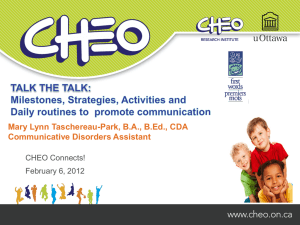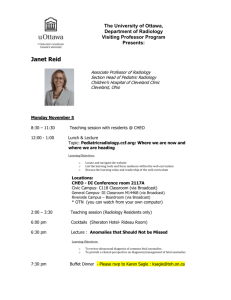When Patients & Families Are the News!
advertisement
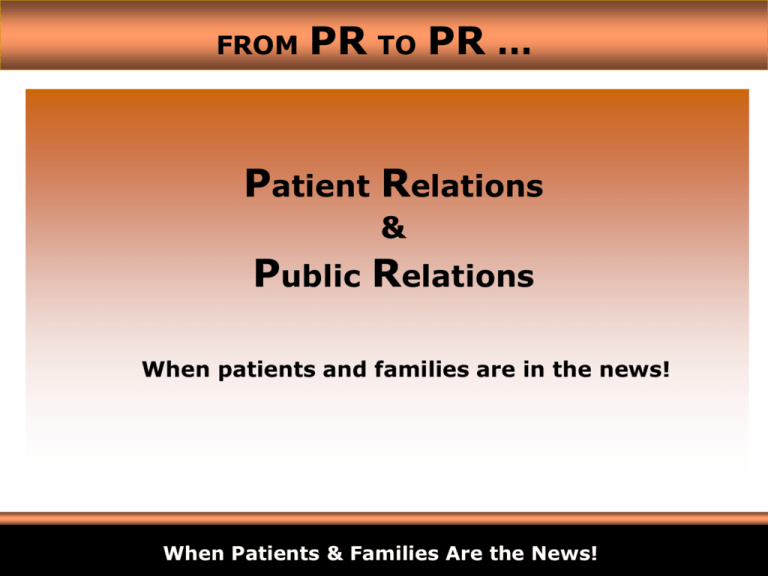
FROM PR TO PR … Patient Relations & Public Relations When patients and families are in the news! When Patients & Families Are the News! FROM PR TO PR … Making the right impression! With Families … PATIENT RELATIONS With the Community … PUBLIC RELATIONS When Patients & Families Are the News! FROM PR TO PR … The Presentation: - What is Patient & Family Relations What is Public Relations Philosophy and Policies Three case studies with lessons learned Questions and Answers When Patients & Families Are the News! FROM PR TO PR … Patient & Family Relations: What “To strengthen, personalize and enhance the relationship between the patient/family and the hospital. To interpret the patient/family’s perspective to the hospital and the hospital’s policies and procedures to the patient and his/her family.” When Patients & Families Are the News! FROM PR TO PR … Patient & Family Relations: How • Coordinate Feedback – Solicited Feedback (satisfaction surveys, focus groups, patient/family advisory committees) – Unsolicited Feedback (compliments, concerns, requests) • Advocate system changes on behalf of patients and families • Provide internal expertise; the system, patient rights vs organization obligations, patient/family centred care When Patients & Families Are the News! FROM PR TO PR … Patient & Family Relations: Successes • Kaitlin Atkinson Family Resource Library • Children’s Library • Family Forum • Youth Forum • Parent Sleep Rooms (ICU/NICU) • Families First Newsletter • Family Guide to CHEO • • • • • • • Patient Directory Reopening of Gift Shop Patient/Family Rep role Family Lounge Confidentiality Awareness Family Faculty Peri-operative parental presence • Family parking rate options When Patients & Families Are the News! FROM PR TO PR … What is PR at CHEO? • • • • • • • Employee communication Media relations Corporate positioning Branding Special events, tours, official openings, etc. Website Community relations When Patients & Families Are the News! FROM PR TO PR … Public Relations that is Patient-Centred Media Support for Patients & Families • • • • • Developed “The Family’s Guide to Media Relations at CHEO” Available 24-7 to support families whose story is of interest to the media (motor vehicle accidents; dignitaries; schoolrelated incident, etc.) Issue statements of behalf of families; Coordinate interviews, accompany media on-site; Provide general counsel on how to handle media interest. When Patients & Families Are the News! FROM PR TO PR … Public Relations that is Patient-Centred Guiding Principles in Media Relations Policy • • • • • To respect the wishes of patients and families To ensure privacy and confidentiality are protected and safeguarded To respond promptly and coordinate interviews in a fair and equitable manner To solicit news coverage that further enhances the profile of CHEO To conduct media relations activities in the spirit of transparency and accountability Partnerships With Families • • • Telethon stories; Official Ceremonies; Advocacies; etc. Use feedback to continuously improve website content Support of Family Advisory Committee activities When Patients & Families Are the News! FROM PR TO PR … Types of News Stories Involving Patients • Media spotlight as a result of :accidents (motor vehicles, ATVs, drownings, falls, school incident, etc.) • Patients and families seek redress through media • Patients and families use media to influence outcomes (i.e. wait times for appointments, etc.) When Patients & Families Are the News! FROM PR TO PR … Type of News Story: Accidents – Case of Public Record Media requests pertaining to the condition of a patient are directed to the Public Relations Department. Public relations staff will release patient condition if the identity of the patient has already been disclosed publicly and if the parent/legal guardian has granted CHEO permission to do so. Public relations staff will recommend to parents/legal guardians that permission be granted to CHEO to issue brief and factual condition updates in an effort to relieve the family of this additional pressure. The attending physician/designate determines that the condition report of a patient – good, fair, serious or critical - is accurately stated. When Patients & Families Are the News! FROM PR TO PR … Responding to complaints …. When Patients & Families Are the News! FROM PR TO PR … The Patient Relations Perspective • Lots of families threaten many things (media,MPP, lawsuits, colleges, picketing of the hospital, cut off donations) in order to be taken seriously. • Very few move forward if they feel… – – – – listened to acknowledged for their stress we’ve learned (make sure it won’t happen again) we’re sincere • Heads up to PR staff of potential media interest is useful • Find out what the family wants and may be able to redirect to more appropriate route • Be neutral on media; discouraging contact gives it power When Patients & Families Are the News! FROM PR TO PR … The Public Relations Perspective - Complaints = negative press. Counteractive to the positive image we aim to project. Transparency. We need to provide some information, but recognize the importance of patient confidentiality. Good relationship with media goes a long way when such issues arise. Keeping families informed of media statement is key. When Patients & Families Are the News! FROM PR TO PR … The Media’s Perspective A complaint is a newsworthy when: - The hospital has not responded to the families’ complaint (no calls, no follow-up, etc.); - The circumstances are credible; - The hospital is potentially at fault; - The complaint appears to be legitimate; - CTV won’t pursue the story if the complainant has not engaged (contacted) the hospital. When Patients & Families Are the News! FROM PR TO PR … The policy says: « Should a family express to the news media their concerns and/or dissatisfaction with the care they received at CHEO, the Patient Representative will contact the family and invite them to discuss their issues directly with CHEO. CHEO will respond to media inquiries in a sensitive and fair manner, while keeping the family informed of all statements being issued. The decision of the family to speak to the media does not relieve CHEO of its responsibility to consider all information concerning a patient confidential. …” (CHEO Media Relations Policy) When Patients & Families Are the News! FROM PR TO PR … What Happens in Reality! Case Study #1 Drowning Case Study #2 Alternative Treatment Case Study #3 Using Media to Influence Outcome When Patients & Families Are the News! FROM PR TO PR … Case Study #1 Tragic Circumstances for Local Family Drowning What worked. What didn’t work. Lessons Learned. What worked: - PR received calls from the media regarding this complaint - Patient and Family Representative initiates contact with the family - PR response to the media: indicate the importance of contacting the family before speaking to the media What didn’t work: - Family did not return any calls from the hospital - Media dropped the story, focus on preventable tragedy Lessons Learned: - Very public story with positive messages for safety - Media interest can add to a family’s burden - Media contact by a family can be a call for help When Patients & Families Are the News! FROM PR TO PR … Case Study #2 Family Opts Out of Treatment What worked. What didn’t. Lessons Learned What worked: - The hospital was open with family on ethical dilemma their choice presented - Team negotiated a monitoring system while consulting CAS What didn’t work: - Clinical decisions getting clouded by media attention - Felt the need to respond for accurate information sharing re chemotherapy and hospital approach to alternative medicine - Family felt betrayed by media and community Lesson Learned: - Transparency in treatment dilemmas can be a risk factor for some media - Need to support staff to focus on clinical care by buffering media attention - Need to stand by a family and support them When Patients & Families Are the News! FROM PR TO PR … Case Study #3 Using Media to Influence Outcome What worked. What didn’t. Lessons Learned What worked: - No story in the end - Lack of clarity contributed to non-story What didn’t work: - Parent wasn’t clear on his message - Complicated issue and didn’t want to wade into someone else’s fight Lesson Learned: - Let the media sort out their story before getting involved; - Link PFR and PR for “high risk” cases When Patients & Families Are the News! FROM PR TO PR … When Patients & Families are the News! - The story belongs to patients …but it involves the hospital; - Families need support when dealing with the media - Perception is reality – if patients feel they have an issue, then the hospital has an issue; - No « typical » story, no family is the same; - When the family favours only one media outlet (exclusivity) but the hospital supports equal access -- no one wins! - In cases of ongoing clinical treatment, keep front-line staff focused on care and not media. When Patients & Families Are the News! FROM PR TO PR … The news stories we prefer! When Patients & Families Are the News! FROM PR TO PR … Questions ???? When Patients & Families Are the News!
